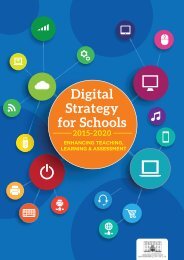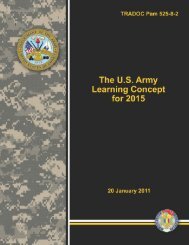Digital Strategy for Schools
TKmc0
TKmc0
Create successful ePaper yourself
Turn your PDF publications into a flip-book with our unique Google optimized e-Paper software.
2. THEME 1: TEACHING, LEARNING AND ASSESSMENT USING ICT<br />
In adopting ICT <strong>for</strong> teaching and learning the Department will ensure that in<strong>for</strong>mation will be<br />
accessible to all learners in line with requirements under the UN Convention on the Rights of<br />
Persons with Disabilities. The Convention emphasises;<br />
• the obligation to ‘provide accessible in<strong>for</strong>mation to persons with disabilities’ (Article.4);<br />
• the need <strong>for</strong> ‘the design, development, production and distribution of accessible ICT’ (Article.9);<br />
• the right to education ‘without discrimination and on the basis of equal opportunity’ <strong>for</strong> persons<br />
with disabilities (Article.24).<br />
ICT has the potential to support learners, whose first language is not English, to enhance their oral<br />
and written literacy. In general, there is a recognition that digital technology has the potential to<br />
create a more inclusive education system <strong>for</strong> all learners.<br />
ICT is a principal enabler <strong>for</strong> children at risk of educational disadvantage, with low levels of<br />
achievement in the <strong>for</strong>mal education system. When it is appropriately embedded into an educational<br />
setting, ICT can enable students to learn in new and exciting ways, encouraging their engagement<br />
and making communication easier. Furthermore, there is evidence to indicate that the creative<br />
application of ICT in education can allow students at risk of early school leaving to connect with<br />
learning in new ways, resulting in improved motivation, attendance and application across subject<br />
areas.<br />
The <strong>Strategy</strong> recognises that ICT has the potential to enable parents/guardians to become more<br />
actively involved in their children’s learning by engaging in conversations with teachers and by<br />
accessing and commenting on students’ work. ICT can also offer new learning possibilities by<br />
connecting with other schools.<br />
DIGITAL CONTENT<br />
The <strong>Strategy</strong> recognises that schools need to have access to a wide range of relevant, high-quality<br />
digital content, which serves to support learners at all stages of our education system.<br />
The <strong>Strategy</strong> will continue to promote Scoilnet - Ireland’s official education portal - and associated<br />
sites as the national reference point <strong>for</strong> schools <strong>for</strong> high-quality digital content and the Arts<br />
in Education Portal 35 as the national reference point <strong>for</strong> schools <strong>for</strong> a high standard of content<br />
supporting digital arts in education.<br />
There is now an opportunity <strong>for</strong> teachers, students and parents/guardians to reduce reliance<br />
on textbooks and move in a planned way towards alternative <strong>for</strong>ms of content that may include<br />
teacher or student-generated resources. In this context, schools can use the Book Grant Scheme<br />
to purchase a range of digital resources relevant to the curriculum. These may include student<br />
subscriptions to online maths or reading programmes, school site licences or app downloads.<br />
PDST TECHNOLOGY IN EDUCATION<br />
PDST Technology in Education (PDST-TiE) promotes and supports the integration of ICT in teaching<br />
and learning in schools. PDST-TiE is part of the national support service, the Professional<br />
35<br />
Arts in Education (http://www.artsineducation.ie)<br />
25




